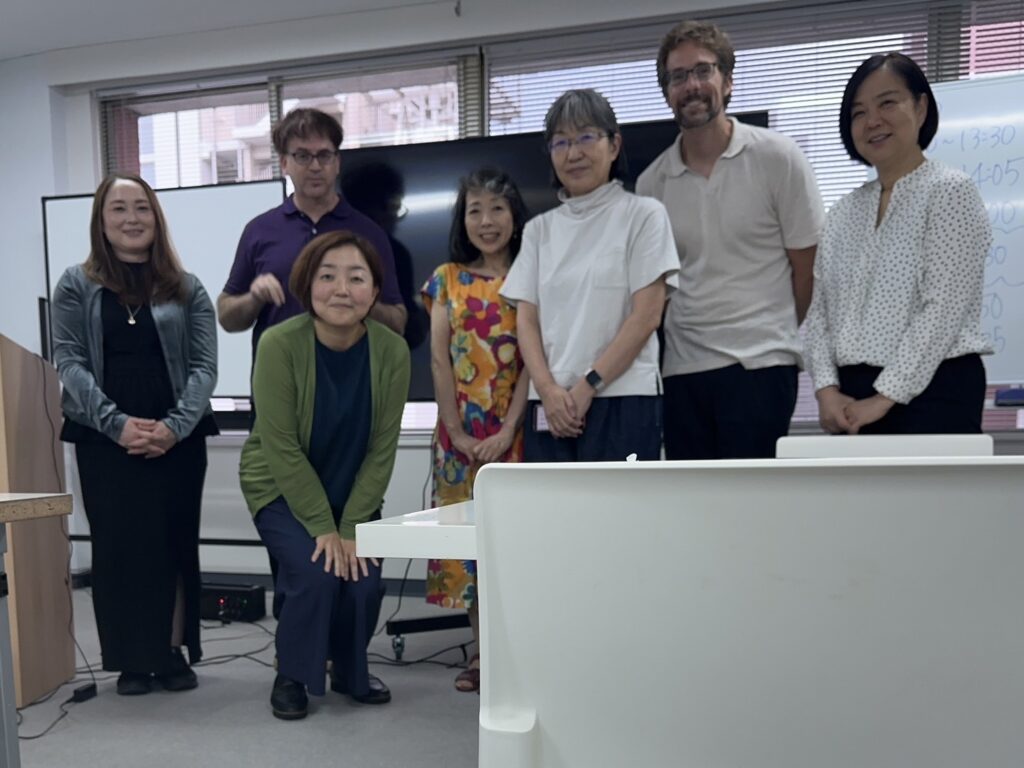ATEM Higashi Nihon Chapter Study Meeting(Zoom Hybrid)
◆日時:2025年5月25日(日)
Date: May 25(Sun.), 2025
◆場所:麗澤大学新宿キャンパス(新宿アイランドタワー 4F)
Place: Shinjuku Campus, Reitaku University(4F, Shinjuku I-Land Tower)
◆Zoom中継:Zoom中継をご覧になる方は、以下のGoogle Formsにて、5月20日(月)23:59までにご登録ください。後日ZoomのURLをお知らせします。
You are kindly asked to register through the following Google Forms by May 20 (Mon.) if you would like to join the meeting online (watching the presentations only). You will be informed of Zoom ID & Pass later.
https://forms.gle/u3aftdjNQJTvJpNb6
◆懇親会:支部例会の後には懇親会も開催します。親睦を深める意味でも、どうぞご参加ください
懇親会申し込みフォーム
https://docs.google.com/forms/d/1oGkBny_rg36SaHrLIbyZyY-7Z36xUHbeTG2OB0kxQIo/edit
<スケジュール Schedule>
ワークショップは60分、プレゼンテーションは30分(発表20分、QA10分)です。
Hands-on Workshop: 60 minutes, Presentation: 30minutes (20 minutes + 10 minutes Q&A)
10:30 – 10:50 ワークショップの準備(希望者)
Optional Preparation / Rehearsal for Workshop Presenters
10:50 – 11:00 開会挨拶 Opening Remarks
11:00 – 12:00 ワークショップ Hands-on Workshop
12:00 – 13:00 お昼休み Lunch
13:00 – 13:30 発表1 Presentation 1
13:30 – 13:35 休憩 Break
13:35 – 14:05 発表2 Presentation 2
14:05 – 14:10 休憩 Break
14:10 – 14:40 発表3 Presentation 3
14:40 – 14:50 閉会の挨拶 Closing Remarks
14:50 – 15:10 会場整理 Room Cleanup
15:10 – 16:00 例会後の役員ミーティング Post-Session Committee Meeting
16:30 – 18:30 懇親会
―――
<プログラム Program>
1.11:00 – 12:00 ワークショップ Hands-on Workshop
「韻を踏む歌とストーリー性のある歌で英語を楽しく学ぼう!」
関口美緒(名古屋大学・University of Maryland)
韻を踏む歌は記憶に残りやすく口ずさみやすい。また、発音やイントネーション・アクセントなど自然に身につく。発表者の経験から、教科書やドリルでは英語が身につかず、成績は底辺だった。しかし、英語の歌に出会ってから、英語の楽しさに触れた。とうとうアメリカのカレッジを飛び級で卒業し、カリフォルニアの大学で教鞭をとるまでになった。言葉とは楽しいものという概念から、みなさんで韻を踏む楽しさを知ってほしい。 ワークショップでは、皆さんの知っている歌やストーリー性のある歌を共有し、一緒に歌い、みなさんに韻を踏む歌詞(詩)を作ってもらい、グループまたは個人で発表してもらう。
Ⅰ. 曲の紹介 (10分)
- 韻を踏む歌
①The Beatles『Revolution』-tionの韻、②Earth Wind and Fire 『September』-berの韻
2. ストーリー性のある歌
①Cinderella 『Somebody Save me』人生の没落
https://aanii.net/somebody-save-me__trashed/
②Boston 『Rock and Roll Band』バンドのサクセスストーリー
Ⅱ. どんな韻が踏めるのか (10分)
皆さんの知っている曲・韻を踏むパターン、意見交換・発表(リスト化)
Ⅲ. グループ活動: 1. 作業 (10分)、2. 発表 (10分)
―――
2.13:00 – 13:30 発表1(発表20分+質疑応答10分)
Presentation 1 (20 min. presentation + 10 min. Q&A)
「授業実践報告: 権威主義と教師像ー映画『いまを生きる』(Dead Poets Society, 1989)の場
合」
日影尚之(麗澤大学)
昨年度の3年次のゼミで映画『いまを生きる』(Dead Poets Society, 1989)を使った。伝統(権威)と自由(解放)の対立項について具体的場面に即して考察・指摘させる活動は一定程度できたと思う。権威の象徴=校長 Mr. Nolanの発言のしかたやその内容、生徒の一人 Neilの父親 Mr. Perryの息子に対する発言、場面の構図など様々な指摘もできるだろう。生徒たちは闇に紛れて洞穴で “Dead Poets Society” 「死せる詩人の会」を復活させる。Neilが『夏の夜の夢』のPuck を演じて間もなく亡くなるなど、独特の「暗さ」を感じさせるのは抑圧体制が続くからだが、Neilや彼の周辺の生徒もディスカッションの良い材料になる。教師像というテーマもトピックになり得るだろう。授業実践も踏まえて、この映画でどのような授業ができそうか、再考してみようと思う。
3.13:35 – 14:05 発表2(発表20分+質疑応答10分)
Presentation 2 (20 min. presentation + 10 min. Q&A)
Comparing the Effects of Serif and Sans Serif Fonts on Reading Accuracy and Speed in Print and
Digital Media on Japanese vs. Korean EFL Learners
Eric Shewack(Rikkyo University)
In consecutive studies by Shewack (2020, 2023), Japanese L1 EFL learners were presented with reading materials in both digital and print format to determine the influence of typeface (serif vs. sans Serif) on reading speed and accuracy. The results of Shewack (2023) suggest that the Japanese participants process text more efficiently when a serif font is used on print media and a sans serif font is used on digital media. These results align with many previous studies by typographers who suggest that the same fonts are also optimal for native English speakers. Recently, a third study was conducted to explore the implications of font selection and media further on L2 English readers, comparing the results of the Japanese students with their Korean counterparts while considering the influence of native orthography. The research, involving 39 university students from each country, compares the effects of serif and sans serif fonts in both print and digital formats. Results indicated that while Japanese students generally exhibited higher accuracy and faster reading times, both groups showed similar trends in font preferences on specific media. Specifically, reading speed was higher with serif fonts in print and sans serif fonts in digital formats. These findings suggest that font effectiveness in enhancing readability may be consistent across different L1 backgrounds, despite variations in orthographic familiarity. The study underscores the importance of font selection in educational materials for EFL learners, highlighting that appropriate font choices can positively influence reading efficiency regardless of the learner’s native language. The presentation aims to share these results to provide EFL educators insight into font selection when creating classroom materials.
―――
4.14:10 – 14:40 発表3(発表20分+質疑応答10分)
Presentation 3 (20 min. presentation + 10 min. Q&A)
「映画字幕翻訳を取り入れた特別授業の実践報告」
守田美子(大妻女子大学)
本発表はプロの映像翻訳者をゲスト講師として迎えて実施した集中授業の実践報告である。学生は、実際に映画やドラマの字幕翻訳や吹替翻訳を担当しているゲスト講師から、字幕翻訳の特性や映像翻訳者の仕事について話を聞いた後、グループに分かれ、映画の短い一場面に付ける日本語字幕を作成した。最後に課題シーンに各グループ作成の字幕を挿入した動画を全員で視聴し、ゲスト講師が講評と添削を行った。 字幕作成では指定文字数内に納めるために余分な情報削除や意訳を行うことがあるが、それには話の流れを理解し、文脈から示唆される会話の意味を正しく推測できることが必要になる。字幕作成は、通常授業での継続的な導入には課題があるが、アクティブ・ラーニングの教授法のひとつとして考えられることを示す。

